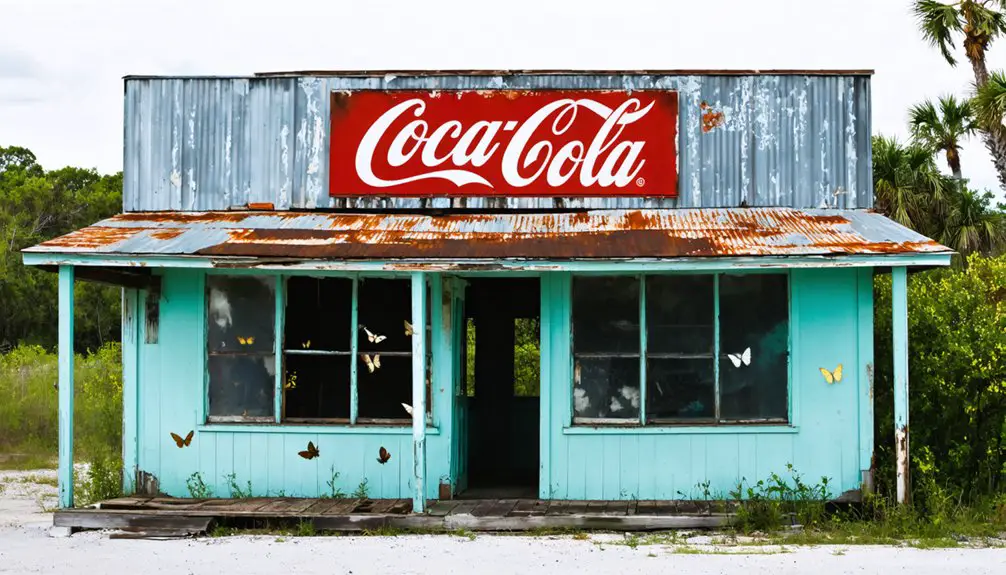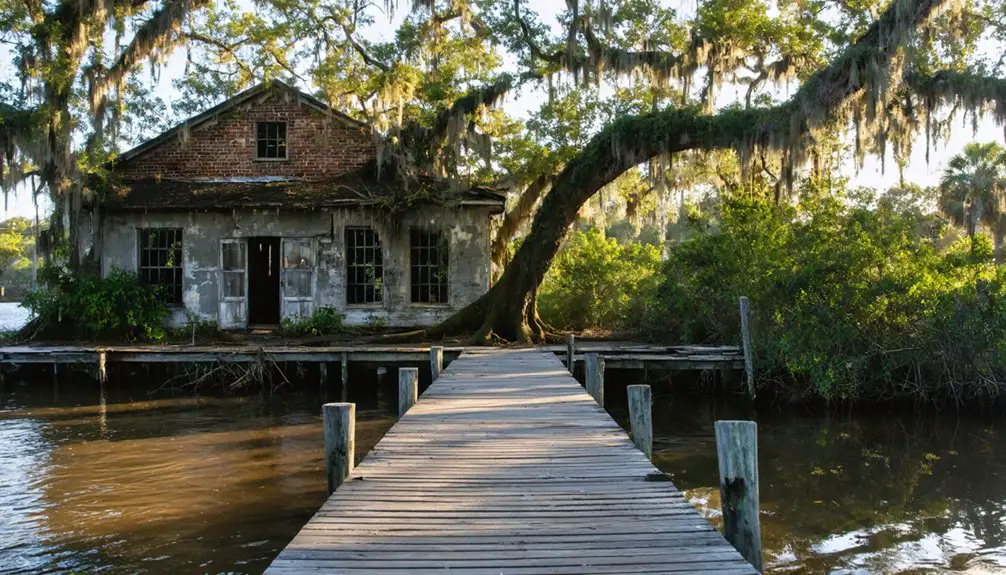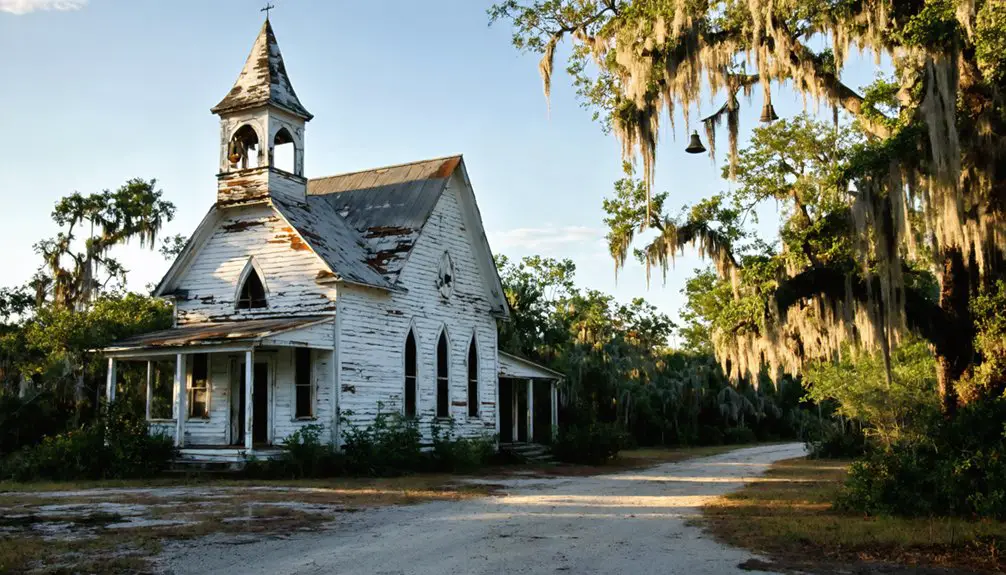The Florida territory’s ownership went between Great Britain and Spain throughout the 18th and part of the 19th century. In 1821, the United States purchased the territory from Spain and welcomed the state of Florida to the union on March 3, 1845, as the 27th state.
There are at least 250 ghost towns in Florida. Due to the state’s low elevation and is mostly surrounded by water, the list of 250 towns is sure to be incomplete as more towns, settlements, and evidence of former communities are discovered both on land and underwater.
Florida is a unique land with many secrets still to be discovered. Portions of the state have been above and below sea level at least four times. For a big part of Florida’s history, the peninsula was underwater.
Being a submerged state, it is almost unbelievable that 250 ghost towns have been found, and leaves the question of how many more ghost towns have been lost underwater. Miami, Key West, St Pete Beach, and Fort Lauderdale are on the list to eventually become future ghost towns if water levels continue to rise in the sea and cause extensive flooding.
Aladdin City, Florida
In 1925, a manufacturer known as The Aladdin Company, known for producing mail-order “kit” homes, bought a large piece of Florida land in the Redland area. Headquartered in Bay City, Michigan, the company wanted to open a sixth location for its operation.
By December 1925, The Aladdin City Sales Co was formed with an opening day for their “dawn-to-dusk” house set for January 14, 1926. The “dawn-to-dusk” house was a preview of the company’s single-day builds. After hundreds of spectators watched a home start and completed within one day, The Aladdin Company sold 874 homesites.
The town of Aladdin City was of Moorish-theme using buildings featured in the company’s 1920 catalog and prepared to house around 10,000 residents. The company was also hoping to attract other manufacturers to the area as the Seaboard Air Line Railway added an extension to their route that would stop in the city.
Due to a government ban on trade and commercial activity in late 1925 for all materials other than food and essentials, followed by the January 1926 sinking of the Prinz Valdemar ship in the Miami Harbor, the end of the land boom was beginning.
In February of 1926, the Aladdin Company purchased a full-page ad in the Homestead Leader, the local newspaper, announcing their plans to fulfill orders with immediate activity from the engineers as soon as the delayed machinery and materials were available. The trade ban and blockage of the ship in the Miami Harbor took a toll on projects being completed for the Aladdin Company and other companies in the area.
Near the end of February 1926, the Redland District Chamber of Commerce took advantage of all the money the Aladdin Company was putting into the community, and Aladdin City was incorporated. By March 1926, a ceremony was held to commemorate the cornerstone of a bank for the city.
More ads were put up in March and April of 1926 that promised more homes and business sites with an invitation to visit the city to see both completed construction and what was being built currently.
By May 1926, the embargo was lifted from the railroad companies, but the land boom was already phasing out. Later that year, a hurricane hit Miami in September, and real estate prices collapsed. In December 1930, when Aladdin City saw fewer sales and the city itself started to fall dormant, the Aladdin City founders started a nationwide raffle for two homes and ten lots.
The winners of the two homes also received round-trip tickets to the city. A similar raffle was planned for 1931, but there was no raffle with the onset of the Great Depression. In 1934, city lots were returned to acreage, and sites were further discounted. By the end of 1936, the Aladdin City Sales Company was disestablished.
A few of the original homes built in Aladdin City lasted over the years, but when Hurricane Andrew hit in 1992, the still-standing structures suffered significant damage. The Seaboard Air Line Railway station, uniquely built of wood unlike other train stations made of stucco and concrete, remained intact, but unfortunately, it was torn down after Hurricane Andrew.
Apix, Florida
Apix, Florida, is known as a ghost town today, but in its prime time, it was not a town. In 1945, a hot topic was using hydrogen as a fuel source. The Air Force and an American aerospace manufacturer known as Pratt & Whitney purchased a ten-square-mile piece of land in Western Palm Beach in 1956.
To keep research hidden and unknown to residents of nearby cities, the town of Apix was described to locals as a fertilizer-producing town. Apix, which stands for Air Products Inc. Experimental, maintained commercial protection to protect the area from potential spectators and had a third party purchase a ranch on connecting land.
Ranch ownership was transferred to the Florida Game and Fresh Water Fish Commission, who gave the Air Force the land to keep curious eyes from uncovering their secret. Land near the testing site was platted for houses, and a fake population was assigned to the town to hide the actual purpose.
Testing liquid hydrogen was the primary purpose of Apix. The U.S. government had been interested in hydrogen as a fuel source since the late 1940s and wanted to find a way to create faster spy planes than the U-2 used at the time.
Project Suntan, which cost nearly $6.2 million daily to transport the liquified hydrogen in an underground pipeline to a testing facility, lasted from 1956 until 1958. Another plant was built in 1959 with a larger capacity, costing approximately $27 million daily.
After a meeting between Apix managers, it was decided to close the town and switch from the underground pipeline to shipping with insulated tanks on the Beeline Highway.
Ellaville, Florida
Founded in 1861, Ellaville was named after one of the founder’s slaves, Ella. George Franklin Drew a successful businessman even before founding Ellaville. Drew built a mansion about half a mile northwest of the townsite surrounded by formal gardens.
Drew and Louis Bucki, a business partner located at the townsite, constructed one of the state’s largest sawmills and employed over 500 people. The Florida Railroad quickly built a railway to the town with direct access to the mill.
Not long after that, the town population increased from a few hundred to nearly 1,000. By the 1870s, the town had a train station, a sawmill, two schools, two churches, a steamboat dock, a masonic lodge, and a commissary. Other businesses started by Drew and Bucki included logging, turpentine, and building railroad cars.
In 1876, George Franklin Drew ran for Florida governor. On January 2, 1877, Drew was officially elected and served until January 4, 1881, when he returned to the lumber business. Drew would relocate to Jacksonville, Florida, at the turn of the century, before dying on September 26, 1900, at 73.
Ellaville remained prosperous until 1898, when the sawmill burned down. The mill was rebuilt, but the amount of lumber left in the area was insufficient to validate the business’s reconstruction. The next event to further push the town into a declining status was flooding the two rivers the town was founded near, the Withlacoochee and Suwannee rivers.
As the Great Depression spread throughout the nation, it became evident that the town had no future. The post office closed in 1942, marking the end of Ellaville.
George Franklin Drew’s mansion in Ellaville remained standing until the 1970s when vandalism and arson damage left the once beautiful two-story structure burnt and in ruins. The Hillman Bridge, built in 1925, was replaced by a new bridge in 1986. Sawmill remains can be found across the river from the Suwannee River State Park townsites. Deserted homes and buildings can also be found in the area.
Rosewood, Florida
Rosewood, Florida, is a tale of unity and tragedy. Founded in 1845 by black and white settlers, the town was remembered to be friendly, happy, and have general unity. Community members worked together to make the town a good place for all.
One of the primary employment sources in the area was the pencil mills that processed the cut cedar trees. When the cedar tree population was cut to minimal amounts, by 1890, the pencil mills closed, and several white residents moved to Sumner, Florida.
Rosewood was now predominantly black, and Sumner white. Still, the residents of both towns remained amicable towards each other in their own town and the other town. In 1915, Rosewood’s population peaked at 355, continuing with a mixed census.
Two families in Rosewood, the Goins and Carriers, were the most influential in the town. The Goins family introduced the town to the turpentine industry, and the Carrier family were the primary loggers in the region. To avoid lawsuits from competitors of the opposite color, the Goin family relocated to Gainesville, and part of the Rosewood population went with them.
In 1920, Rosewood was a mostly self-sufficient community. There were three churches, a school, a masonic hall, a turpentine mill, two general stores, a sugarcane mill, and even a baseball team. Several homes of various designs, including two stories, small two-room houses, and plank structures for storage. A symbol of middle-class prosperity was to own a piano or organ, which some Rosewood families did. Business ownership was by both colors of the population, and all businesses were equally successful.
Tragedy struck in 1923 when a married woman from another town knowingly and falsely accused an unidentified colored resident from Rosewood of violently attacking her. The real story behind her accusation was due to a wrong choice she had made after having an affair but did not want to be publicly shamed.
The residents of Rosewood denied any such attack ever happening and defended one another against the rumor. Because no person was identified or anyone who pleaded guilty to the charge, a group of men from the other town organized a raid on Rosewood, burning almost all structures down.
Survivors of the raid hid in wells and swamps until they could be evacuated by train and car to larger towns. Homes and businesses became ash and debris, possessions were destroyed, and lives were lost. After being evacuated out of the wreckage, the town was abandoned. None of the surviving former residents returned to Rosewood. The events in 1923 were later referred to as the Rosewood Massacre.
In the 1950s, various businesses returned to Rosewood to re-establish what was lost. Rosewood’s new companies included a general store, fisheries, charter tours, Mollusca, clam, and oyster farming, agricultural farms, restaurants, and even a small airfield that was constructed nearby. As businesses began seeing steady traffic, neighborhoods were developed to re-introduce a permanent population.



